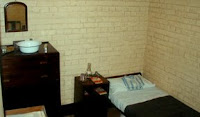
October 7, 2007: Cabinet War Rooms
“If you were lucky enough to receive a ration of sugar, as this officer was, you would place it in an envelope, write your name on it, and hide it in a drawer. That’s what this Officer did, and there it stayed from 1945 until these rooms were opened again in the 1970s.” Audio Tour, Cabinet War Rooms

Deep below the
When peace came, members of the staff closed up the room and went home (some of them, according to the audio tour, for the first time in six years). These rooms were left, all but forgotten, until Margaret Thatcher had them opened to the public in the early years of her premiership. In some cases, things had been left exactly as they had been on V.E. day…in other cases, the rooms have been restored using detailed photographs taken during the 40s. The final effect is stunning…it truly feels as if everyone just left- despite the fact that they’ve been gone now for over half a century.
This was not a comfortable place, to be sure. It was, as it was designed to be, cut off from the world above by an enormous concrete slab which protected the roof of the chamber from falling bombs. There was very little egress to the outside world. On those occasions when it was possible to leave the shelter, it was to face a world destroyed...only upon reaching the street would the answer come: which national landmark had been bombed, whose house destroyed, whose family was dead. (Alan Murdie, the Ghost Host on Russell’s tour, told me that he had once known a chap who had gone to work in the morning, and when he came home that night, he found that his entire family had been wiped from the face of the earth by German Bombs.)
In one hallway was a door (still there) marked, W.C., and the “occupied” sign was always on (it still is). According to the audio tour, almost all members of the staff assumed that this was the only working toilet (or Water Closet) in the entire bunker….probably reserved exclusively for the Prime Minister.
Inside, however, was not a commode, but a closely guarded secret…hidden from nearly all: a transatlantic “hotline” (the first of its kind, in fact) linking Churchill directly with Franklin Delano Roosevelt in the White House. This direct line of communication between the President and the Prime Minister was of vital importance in coordinating the Anglo-American alliance which would defeat Hitler.
Elsewhere in the exhibit, are tableaus, illustrating the P.M.’s bank of typists at work, or a pair of general officers going over the details of an operation. A BBC technician sits at his transmitter, ready to relay one of Churchill’s incomparable speeches to the outside world, while down the hall, officers (including the one who had the sugar) man the phones and keep the situation updated.
The pins marking the positions of allied and enemy troops remain in the map on the wall as they were left.
One room is set aside to relate the story of the “Dig For Victory” campaign. With U-Boats prowling the shipping lanes,
Outside the bunker, at night, Londoners slept inside the tube stations side by side with complete strangers. Inside the war rooms, the secretaries and other clerical staff retired to “the Dock”…a low, stark tunnel under the main structure.
Higher level aids to the Cabinet and the General Staff slept in private rooms- each about the size of a walk-in closet. These rooms are full of relics from early twentieth century life- matches, ashtrays, bedpans, pajamas folded neatly on the bed, and Penguin paperbacks on the night stand, as if waiting for their owners to return.
It is these little touches which lend such verisimilitude to the exhibit…not the lofty medals, film footage, or maps…but the tiny little pieces of flotsam that people carry with them to make life comfortable, bearable, even under the most adverse circumstances.
Thus, this shrine to the heroic resistance of Great Brittan against Nazi tyranny (a rearguard action which saved the world) is celebrated, not by glorious statues- but by the completely everyday and mundane.
I think it was this that Bobbi found so fascinating, and I, who tend to have my head turned by the glorious, was also enthralled by what really turned out to be a monument to the struggle of the average Englishman against the most ruthless assault of evil the world has yet known.
Churchill himself said, and after seeing this exhibit, it is impossible not to agree:
“It was the nation, and the race, dwelling all ‘round the globe, that had the Lion’s Heart.
I had the luck to be called upon to give…
…the Roar.”














 If you like Rip and Read, check out
If you like Rip and Read, check out
No comments:
Post a Comment